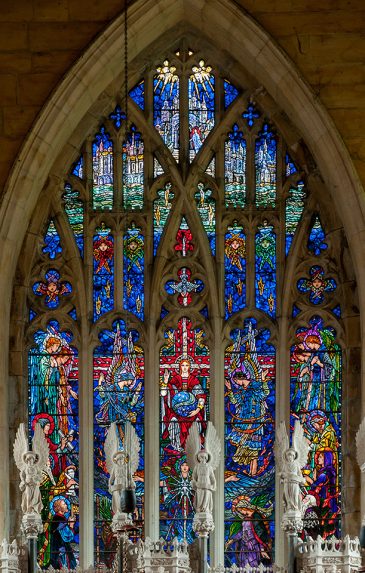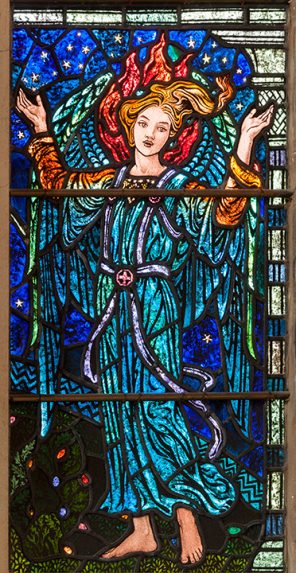Church of All Saints, Porthcawl, Bridgend
Address
Church of All Saints, Victoria Avenue, Porthcawl CF36 3HDRecommended by
Highlight
Te Deum, east windowArtist, maker and date
Designed by Karl Parsons and made at Lowndes & Drury, 1927Reason for highlighting
This sumptuous five light window represents Christ in Majesty between angels with scenes and figures from the Old and New Testaments below. Sparing no expense, the donor requested stained glass fill the lower parts of the window regardless of the fact that the stone reredos completely obscured them. The window is representative of how Karl Parson’s work developed following his visit to Chartres Cathedral in 1924.
Artist/maker notes
Karl Bergemann Parsons (1884-1934) was born in Peckham, south London, and, like his friend Edward Woore, graduated in his craft from Christopher Whall’s studio, which he had joined directly from school. Having completed his apprenticeship he remained with Whall until setting up his own studio at The Glass House in 1908. During this time he was able to work with Whall on some of his most important commissions, including the windows of the Lady Chapel at Gloucester Cathedral, and also supplying some drawings for Whall’s book ‘Stained Glass Work’ (1905).
Parson’s time with Whall included attending Whall’s classes at the Central School of Arts & Crafts, where he himself would subsequently teach. He also taught at the Royal College of Art.
Parson’s style evolved noticeably from the mid-1920 following a visit to Chartres Cathedral and under the influence of his friend, Harry Clarke. His sometime pupil and later assistant, E Liddall Armitage commented some years later that “He was an extremely competent designer, an excellent draughtsman and a fine colourist.”
Sources:
Arts & Craft Stained Glass by Peter Cormack (Yale University Press, 2015)
Stained Glass – History, Technology and Practice by E Liddall Armitage (Leonard Hill (Books) Ltd, 1960)
Lowndes & Drury was formed in 1897, by the artist Mary Lowndes (1857-1929) and the craftsman Alfred John Drury (1868-1940), with the aim of providing facilities for independent artists to design and make stained glass windows. They moved from cramped conditions in Chelsea to newly purpose-built premises, The Glass House, in 1906. The firm continued after the founders’ deaths, under Alfred Drury’s son, Victor, until he retired in the early 1970s. However, The Glass House premises continued in use under Carl Edwards and subsequently his daughter, Caroline Benyon, until she moved her studio to Hampton in 1992.
Source: The Journal of Stained Glass, Vol. XLI, 2017



Other comments
Two windows of 1964 on the north wall of the north chapel (Chapel of St David) are rare works in Wales by the Welsh-born artist Leonard Evetts, who made dozens of windows for the north-east of England.
Further information:
Stained Glass in Welsh Churches by Martin Crampin (Talybont: Y Lolfa, 2014)
Stained Glass in Wales – Church of All Saints, Porthcawl